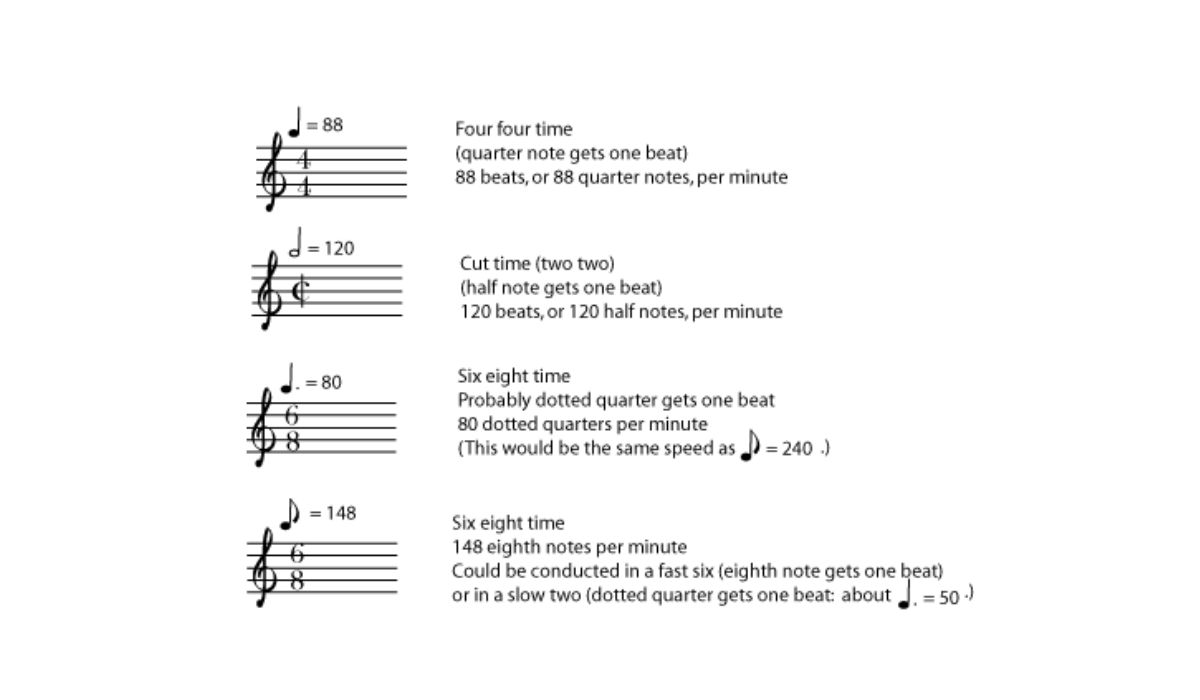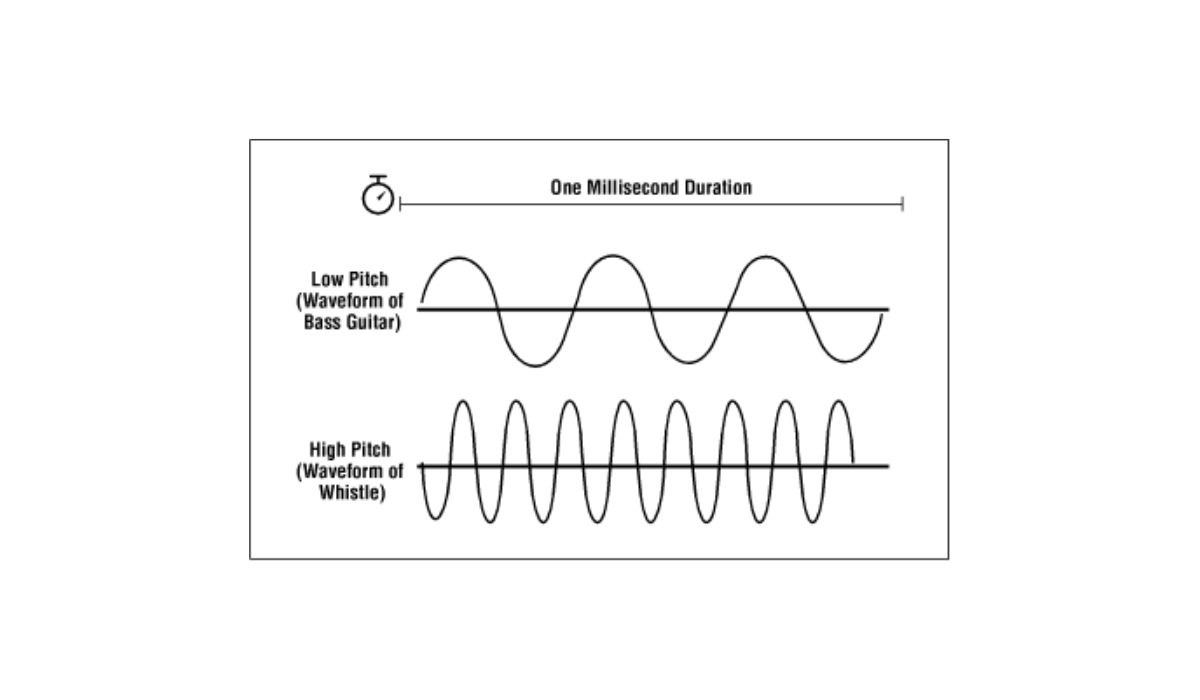Home>Production & Technology>Metronome>What Are Metronome Markings And How Are They Related To Tempo


Metronome
What Are Metronome Markings And How Are They Related To Tempo
Modified: January 22, 2024
Discover the significance of metronome markings and their correlation with tempo. Learn how the metronome tool helps musicians maintain precise timing and rhythm.
(Many of the links in this article redirect to a specific reviewed product. Your purchase of these products through affiliate links helps to generate commission for AudioLover.com, at no extra cost. Learn more)
Table of Contents
Introduction
Music is a universal language that speaks to our emotions, evokes memories, and can transport us to different times and places. Whether you are a musician, music lover, or simply appreciate the power of music, you have likely come across the term “metronome markings” in your musical journey. Metronome markings play a crucial role in ensuring that a musical composition is performed with the correct tempo and rhythm.
But what exactly are metronome markings? In essence, metronome markings are a way of indicating the tempo or speed at which a piece of music should be played. They provide a reference point that helps musicians maintain a consistent tempo throughout the performance. Metronome markings are typically indicated by a number, which represents the beats per minute (BPM), and are accompanied by a musical symbol called a metronome symbol.
The use of metronome markings can be traced back to the early 19th century when the metronome, an invention by Johann Nepomuk Maelzel, became widely available. Before the invention of the metronome, musicians relied on more subjective terms such as “allegro” (fast), “adagio” (slow), or “moderato” (moderate) to indicate the desired tempo. However, these terms were open to interpretation and could vary from one musician to another.
With the introduction of the metronome, composers and musicians had a more precise tool to communicate the desired tempo of a piece. This led to the adoption of standardized metronome markings in musical notation, ensuring greater accuracy and consistency in performance.
Next, let’s delve deeper into the definition of metronome markings and explore why they are important in the world of music.
Definition of Metronome Markings
Metronome markings, also known as tempo markings, are notations in musical scores that indicate the desired tempo or speed at which a piece of music should be performed. They provide a precise numerical value, typically denoted in beats per minute (BPM), to guide musicians in maintaining a consistent tempo throughout their performance.
Metronome markings are represented by a number and are often accompanied by a metronome symbol, which resembles a vertical line with a dot on top. The number indicates the number of beats per minute, representing the pace at which the music should be played. For example, a metronome marking of “120 BPM” would mean that there should be 120 beats in one minute.
These tempo markings help musicians stay synchronized and maintain a consistent rhythm throughout a piece of music. They provide a framework for the timing and flow of the music, ensuring that performers stay in sync with each other and accurately convey the intended mood and character of the composition.
Metronome markings can vary widely depending on the style, time period, and genre of the music. For example, a fast-paced piece might have a high BPM such as 160 or 180, indicating a rapid tempo, while a slow and melodic piece might have a lower BPM like 60 or 70, representing a much slower tempo.
It is important to note that while metronome markings provide a clear indication of tempo, they are not the sole determinant of musical expression. Musicians still have the flexibility to infuse their own interpretation, dynamics, and phrasing into the music, even when adhering to a specific metronome marking. The markings serve as a guide, but ultimately, it is the performer’s artistry that brings the music to life.
Metronome markings can be found in various types of musical notation, including sheet music, music software, and digital audio workstations (DAWs). They are commonly used in classical, jazz, pop, and other genres of music, ensuring that performers stay in sync and maintain the desired tempo throughout their performance.
Now that we have established the definition of metronome markings, let’s explore why they are so important in the world of music.
Importance of Metronome Markings in Music
Metronome markings play a vital role in the world of music, ensuring precision, consistency, and musicality in performances. Here are several reasons why metronome markings are of paramount importance:
- Precise Tempo Control: Metronome markings provide a clear and objective indication of the desired tempo. They eliminate ambiguity and allow musicians to maintain a consistent pace throughout a piece. This precision helps create a cohesive and synchronized sound, especially in ensemble performances.
- Musical Interpretation: While metronome markings provide a baseline for tempo, they also offer room for interpretation and expression. Musicians can infuse their personal style, dynamics, and phrasing while adhering to the overall tempo. Metronome markings provide a framework for musical expression and ensure that the essential rhythmic structure of a composition is maintained.
- Training Tool: Metronome markings are invaluable in practice sessions, serving as a fundamental tool for developing a strong sense of rhythm, timing, and precision. Practicing with a metronome helps musicians improve their technical skills, internalize rhythmic patterns, and build the muscle memory necessary for accurate performances.
- Ensemble Performance: Metronome markings are particularly important in ensemble performances where multiple musicians must synchronize their playing. By adhering to a common metronome marking, ensemble members stay in sync, creating a unified and harmonious sound. This precision enhances the overall musical experience for both performers and listeners.
- Consistency in Different Settings: Metronome markings facilitate consistency in performances across different settings, such as rehearsals, live concerts, and recordings. They serve as a reference point, ensuring that the tempo remains constant regardless of external factors like nerves, venue acoustics, or adrenaline. This consistency allows musicians to deliver reliable and professional performances.
- Understanding the Composer’s Intentions: Metronome markings provide insight into the composer’s intentions regarding tempo and pacing. They offer guidance on the specific character, mood, or emotion that the music should convey. By paying attention to the metronome markings, musicians can faithfully interpret the composer’s vision and bring their compositions to life.
Overall, metronome markings are indispensable tools in music, enabling musicians to maintain precision, expressiveness, and cohesion in their performances. They enhance the musical experience for both performers and listeners, contributing to the richness and integrity of the art form.
How Tempo Relates to Metronome Markings
Tempo is a fundamental aspect of music that refers to the speed at which a piece is performed. It provides a sense of rhythm, energy, and flow to the music. Metronome markings are closely related to tempo, as they serve as a guide for musicians to maintain a consistent speed throughout a performance.
Metronome markings indicate the beats per minute (BPM), which represents the number of beats or pulses in one minute. The higher the BPM, the faster the tempo, and the lower the BPM, the slower the tempo. For example, a metronome marking of 120 BPM indicates that there should be 120 beats in one minute, while a marking of 60 BPM indicates a slower tempo with 60 beats per minute.
The relationship between metronome markings and tempo is essential for achieving musicality and synchronization. By adhering to a specific metronome marking, musicians can ensure that they are playing at the desired tempo set by the composer. This consistency is vital for ensemble performances, where multiple musicians must play in unison, as well as for solo performances, where a steady tempo creates a sense of stability and coherence.
Metronome markings help musicians maintain a steady rhythm and prevent fluctuations in tempo. This consistency allows for accurate timing between different sections of a composition and ensures a seamless flow of the music. It also helps musicians maintain a sense of control, especially during challenging passages that require precision and accuracy.
However, it’s important to note that metronome markings are not rigid rules that must be strictly followed. Musicians can use them as a starting point and then make musical interpretations and adjustments as necessary. For instance, certain musical styles may call for slight variations in tempo, such as rubato in classical music, where the tempo is slightly altered for expressive purposes.
Ultimately, the relationship between tempo and metronome markings is a dynamic one. Metronome markings serve as a reference point for establishing and maintaining a consistent tempo in music. They provide a framework for musicians to synchronize and create a cohesive performance. By understanding how tempo relates to metronome markings, musicians can effectively develop their timing and rhythmic skills, express the composer’s intentions, and deliver captivating musical experiences.
Different Types of Metronome Markings
Metronome markings come in various forms, representing different rhythmic patterns and styles. Understanding these different types of metronome markings can help musicians interpret and perform music with accuracy and precision. Here are some common types of metronome markings:
- Standard BPM Notation: The most common type of metronome marking is the standard BPM notation, which indicates the beats per minute. For example, a marking of “120 BPM” means there should be 120 beats in one minute. This type of marking provides a specific and precise indication of the desired tempo.
- Italian Tempo Markings: In addition to standard BPM notation, many musical compositions include Italian tempo markings. These markings often provide descriptive terms indicating the desired speed and character of the music. For example, “allegro” suggests a fast and lively tempo, while “adagio” indicates a slow and leisurely pace. Italian tempo markings can give musicians additional insight into the intended mood and style of the piece.
- Dotted Metronome Markings: Dotted metronome markings are used to indicate a specific note value that should be played per beat. For example, “60 BPM (dotted quarter note)” means that there should be 60 dotted quarter notes played in one minute. This type of marking helps musicians maintain a consistent rhythm and properly execute syncopated or complex rhythms.
- Subdivisions: Metronome markings can also incorporate subdivisions, indicating how the beats are divided within each measure. For instance, “80 BPM (with eighth note subdivisions)” implies that there should be 80 beats per minute, with each beat subdivided into two eighth notes. This type of marking is particularly useful for maintaining a steady and precise sense of timing.
- Accented Metronome Markings: Accented metronome markings are used to highlight specific beats in a measure. For example, “120 BPM (with downbeat accents)” means that the first beat of each measure should be emphasized or accentuated. This type of marking helps musicians emphasize the strong beats and create a sense of structure and emphasis within the music.
- Changing Metronome Markings: In some musical compositions, the tempo can change throughout the piece. In these cases, the metronome markings will reflect the desired tempo changes, indicating when and how the speed should be adjusted. These changing metronome markings help musicians maintain a seamless transition between tempos and ensure a cohesive and polished performance.
These different types of metronome markings provide musicians with valuable information about the desired tempo and rhythmic patterns of a piece. By accurately interpreting and applying these markings, musicians can achieve a more authentic and faithful performance, staying true to the composer’s intentions.
Interpreting and Using Metronome Markings
Interpreting and using metronome markings effectively is key to achieving accurate tempo and rhythm in music. Here are some important considerations when working with metronome markings:
1. Understanding the BPM: First and foremost, it is crucial to understand the BPM indicated by the metronome marking. This numerical value represents the beats per minute and provides a precise indication of the desired tempo. Take the time to internalize the specific BPM and its corresponding speed before starting to play.
2. Finding a Comfortable Starting Point: When beginning a new piece or section, it can be helpful to start with a slightly slower tempo than indicated and gradually work up to the desired speed. This allows for a smoother transition and helps musicians establish a solid rhythmic foundation.
3. Practicing with the Metronome: Practice sessions with a metronome are essential for developing rhythmic accuracy and precision. Set the metronome to the indicated BPM and practice playing the music in time with the beats. Focus on maintaining a steady pace and internalizing the rhythm of the piece.
4. Experimenting with Subdivisions: Some metronome markings include subdivisions, indicating how the beats are divided within each measure. Experiment with playing the piece using these subdivisions to reinforce a sense of timing and learn to execute more complex rhythms accurately.
5. Expressive Interpretation: While metronome markings provide a foundation for tempo, it is important to remember that music is a form of artistic expression. Use the metronome marking as a guide but allow room for interpretation and musicality. Make slight adjustments in tempo or dynamics to convey the intended mood and emotion of the music.
6. Listening to the Metronome: Be attentive to the metronome while playing. Pay close attention to how your playing aligns with the beats, aiming for precise timing and coordination. Focus on playing in sync with the metronome and adjusting your tempo accordingly.
7. Recording and Analyzing: Utilize technology to your advantage by recording yourself playing with the metronome. Listen back to the recording and analyze your performance in relation to the metronome marking. Identify areas where you may need to improve your timing or rhythm and make adjustments in subsequent practice sessions.
8. Collaborative Playing: When playing in an ensemble or with other musicians, ensure that everyone is aware of and following the same metronome marking. This ensures synchronization and a cohesive performance.
Remember, metronome markings are meant to serve as a guide. While they provide essential structure and rhythm, they should not inhibit musical expression. Use them as a tool to refine and enhance your performances, while still allowing room for personal interpretation and artistry.
Examples of Metronome Markings in Famous Compositions
Metronome markings can be found in countless musical compositions across various genres and time periods. Here are a few examples of famous compositions and their associated metronome markings:
- Beethoven’s Symphony No. 5: In the iconic first movement of Beethoven’s Symphony No. 5 in C minor, the metronome marking is indicated as “Allegro con brio” with a metronome marking of around 108-112 BPM. This marking sets the energetic and dramatic pace for the symphony, propelling the famous “da-da-da-dum” motif.
- Mozart’s Symphony No. 40: Mozart’s Symphony No. 40 in G minor is known for its passionate and melancholic melodies. The first movement, marked “Molto allegro,” has a metronome marking of around 138-144 BPM. This brisk tempo adds to the urgency and intensity of the composition.
- Chopin’s Nocturne in E-flat Major: Chopin’s Nocturne in E-flat Major, Op. 9, No. 2 is a beloved piano piece known for its lyrical and expressive nature. The metronome marking indicates “Lento sostenuto” with a tempo of around 76-80 BPM. This slower tempo allows for the beautiful phrasing and delicate nuances that define the Nocturne genre.
- Debussy’s Clair de Lune: Debussy’s Clair de Lune, from his Suite bergamasque, is a delicate and dreamlike piano piece. The metronome marking suggests “Andante très expressif” with a tempo of around 58-60 BPM. This slower tempo enhances the ethereal and introspective nature of the composition.
- The Beatles’ “Yesterday”: Even in popular music, metronome markings play a role. The Beatles’ iconic song, “Yesterday,” is often performed at a metronome marking of around 80 BPM. This moderate tempo allows for the poignant lyrics and melodic beauty of the song to shine.
These examples demonstrate the diversity of metronome markings in famous compositions. From classical symphonies to contemporary pop songs, metronome markings ensure a consistent sense of tempo and rhythm, emphasizing the intended mood and expressive qualities of the music.
It is worth noting that while metronome markings provide valuable guidance, interpretations and performance styles can vary. Musicians may choose to slightly deviate from the indicated tempo to infuse their own artistry and emotional expression into the performance. The flexibility within the framework of metronome markings allows for a balance between precision and individual interpretation.
These examples reflect just a fraction of the vast repertoire where metronome markings play a significant role in the interpretation of music. Exploring and studying metronome markings in various compositions can deepen our understanding and appreciation of the intended tempo and the composer’s artistic vision.
Conclusion
Metronome markings are an essential component of music that provide a precise indication of tempo and rhythm. They serve as a guide for musicians, ensuring consistency, precision, and synchronization in performances. By adhering to metronome markings, musicians can maintain a steady pace and accurately convey the intended mood and character of a composition.
Throughout this article, we have explored the definition of metronome markings, their importance in music, and how they relate to tempo. We have also delved into different types of metronome markings and provided examples of their usage in famous compositions. It is clear that metronome markings are invaluable tools for musicians, contributing to the overall integrity and musicality of performances.
While metronome markings provide a reliable framework, they are not meant to restrict artistic interpretation. Musicians have the freedom to express themselves within the context of the metronome marking, allowing for individuality and creativity to shine through.
Whether you are a performer, composer, or music enthusiast, understanding and utilizing metronome markings can greatly enhance your musical experiences. Through practice, experimentation, and attention to detail, you can master the art of interpreting and applying metronome markings to achieve precision, expressiveness, and cohesion in your performances.
So the next time you encounter a metronome marking in a musical score or hear the steady beat of a metronome, embrace its guidance and let it inspire you to create rhythmic and captivating music.











